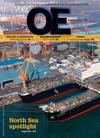
Page 129: of Offshore Engineer Magazine (Aug/Sep 2014)
Read this page in Pdf, Flash or Html5 edition of Aug/Sep 2014 Offshore Engineer Magazine
Directorate (OISD) and gave it authority (PFEER) 1995 should clearly describe the following
HSEQ • to formulate and coordinate the imple- 1996: The Offshore Installations and elements: • mentation of a series of self regulatory Wells (Design and Construction, etc) The system and its operational context. • measures for enhancing the safety in the Regulations 1996. The safety claims and safety criteria.
• local oil and gas industry. The most important of all, the Offshore Hazard Identifcation and Risk
India’s government also created Installations (Safety Case) Regulations Assessment.
•
Petroleum and Natural Gas (Safety in 2005, came into force in 2006, which Risk control measures and their
Offshore Operations) Rules, 2008, to made it mandatory for the operator or effectiveness.
regulate safety in offshore exploration, owner to prepare a safety case and sub- Why the residual level of risk is exploitation, conservation and manage- mit it to HSE for acceptance. acceptable: • ment of petroleum and natural gas and Safety case: For submitting a safety case, Roles, responsibilities, organizational matters connected therewith. PNG Rules, the operator has to prepare a detailed and safety policies and organizational safety 2008, follow a goal-setting approach, structured argument to establish that the management system.
i.e. what is to be achieved rather than oil facility is safe. In general, a safety case The challenge is to present the prescribing specifc solutions.
Solutions chosen by the operator shall be based on customary practice in the industry, requirements, and specifcations appearing in other documents such as nationally and internationally recognised industrial standards (e.g standards like
API, ISO, OISD), codes and conventions (e.g. MARPOL, SOLAS, ISM, MODU code).
However, evidence in form of documenta- tion, demonstrating that solutions selected by the operator fulfll the functional requirements of the rules, shall be main- tained by the operator at all times. Safety systems of Indian operators such as ONGC and GSPC comply, among others, with API
RP 75, API RP 14J and API RP 2C.
Guidance notes issued by OISD in
April 2012 made it mandatory for opera- tors to get a valid certifcate issued by an independent party (including a clas- sifcation society ) to achieve the “ft for purpose” status for an oil installation.
UK regulations
In the UK, The Health and Safety at Work
Act 1974 is the primary piece of legisla- tion covering occupational health and safety. The Health and Safety Executive (HSE) with local authorities (and other enforcing authorities) is responsible for enforcement. The Piper Alpha disaster was a watershed event in UK offshore, which caused a paradigm shift in off- shore safety systems not only in the UK , but in the offshore industry worldwide.
After Piper Alpha, the UK introduced the most comprehensive legislation for protection of workers and ensuring integ- rity of installations. A few of the regula- tions include: • 1992: Management of Health and Safety at Work Regulations 1992 • 1995: The Offshore Installation • 1995: Pipeline Works (Management and
Administration) Regulations • 1995: Prevention of Fire and Explosion, and Emergency Response Regulations
August.indd 12 7/16/14 2:16 PM oedigital.com August 2014 | OE 131 042_OE0814_EPIC1_safety.indd 131 7/23/14 1:27 AM

 128
128

 130
130